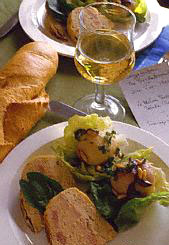


Few people today would disagree with Brillat-Savarin, who pointed out that "the right order of drinking is from the mildest wines to the headiest and most perfumed". As a general rule, we still serve wines in a certain order throughout a meal: young wines are followed by older vintages, light wines by fuller-bodied or more alcoholic ones, chilled wines by those that have become chambre (room temperature), dry wines by sweet.
The rule can be broken judiciously, particularly at the beginning and end of a meal; even Brillat-Savarin began with madeira (hardly a "mild" wine), with "French wines to accompany the main courses, and African and Spanish wines to crown the meal". Tastes in aperitifs, drunk before the food arrives to stimulate the appetite, vary widely. Only the fact that they are drinks of pronounced character, usually served well chilled, link the vermouths of France and Italy, America's cocktail or gin and tonic, Greece's ouzo and northern Europe's schnapps.
If wine is an important part of a meal, it is often frowned upon to dull the palate with spirits first, but any number of characterful wines (usually white) make admirable aperitifs. Champagne is excellent anywhere in the world; fino or manzanilla sherry is now as popular in Britain as it is in Spain; chilled ruby or tawny port is seen in France as often as sweet white wines (Sauternes, the South-West's Jurancon, Muscat de Beaumes-de-Venise) and aromatic dry Alsace Muscats and Rieslings.
German wines are increasingly being made dry, to be drunk throughout a meal, but traditional practice was to serve the light, fragrant, sweetish wines on their own, or as an aperitif and again after the meal.
The question of whether to serve cheese followed by pudding, or vice versa, is not so much one of French versus British practice, as one of personal taste. If cheese follows the main course, the red wine served with the meat — or a similar but superior wine — also accompanies the cheese. A sweet dish is then last on the menu, accompanied by a glass of champagne. British households tended to follow meats with sweet dishes, which were served with sweet wines from Sauternes, Barsac or Tokaji. The final course was cheese and dessert, which meant fresh and dried fruit and nuts, with port, oloroso sherry, or Bual or Malmsey madeira.
|
|
|




